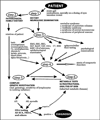Spinocerebellar ataxia: patient and health professional perspectives on whether and how patents affect access to clinical genetic testing
- PMID: 20393313
- PMCID: PMC3138714
- DOI: 10.1097/GIM.0b013e3181d67e44
Spinocerebellar ataxia: patient and health professional perspectives on whether and how patents affect access to clinical genetic testing
Abstract
Genetic testing for spinocerebellar ataxia is used in diagnosis of rare movement disorders. Such testing generally does not affect treatment, but confirmation of mutations in a known gene can confirm diagnosis and end an often years-long quest for the cause of distressing and disabling symptoms. Through interviews and a web forum hosted by the National Ataxia Foundation, patients and health professionals related their experiences with the effect of patents on access to genetic testing for spinocerebellar ataxia. In the United States, Athena Diagnostics holds either a patent or an exclusive license to a patent in the case of six spinocerebellar ataxia variants (spinocerebellar ataxia 1-3 and 6-8) and two other hereditary ataxias (Friedreich's Ataxia and Early Onset Ataxia). Athena has enforced its exclusive rights to spinocerebellar ataxia-related patents by sending notification letters to multiple laboratories offering genetic testing for inherited neurological conditions, including spinocerebellar ataxia. Roughly half of web forum respondents had decided not to get genetic tests. Price, coverage and reimbursement by insurers and health plans, and fear of genetic discrimination were the main reasons cited for deciding not to get tested. Price was cited as an access concern by the physicians, and as sole US provider, coverage and reimbursement depend on having payment agreements between Athena and payers. In cases in which payers do not reimburse, the patient is responsible for payment, although some patients can apply to the voluntary Athena Access and Patient Protection Plan offered by the company.
Figures



References
-
- Schols L, Bauer P, Schmidt T, Schulte T, Riess O. Autosomal dominant cerebellar ataxias: clinical features, genetics, and pathogenesis. Lancet Neurol. 2004;3(5):291–304. - PubMed
-
- Taroni F, DiDonato S. Pathways to motor incoordination: the inherited ataxias. Nat Rev Neurosci. 2004;5(8):641–655. - PubMed
-
- Moseley M, Benzow K, Schut L, et al. Incidence of dominant spinocerebellar and Friedreich triplet repeats among 361 ataxia families. Neurology. 1998;51(6):1666–1671. - PubMed
-
- Mori M, Adachi Y, Kusumi MNK. A genetic epidemiological study of spinocerebellar ataxias in Tottori prefecture, Japan. Neuroepidemiology. 2001;20(2):144–149. - PubMed
-
- van de Warrenburg B, Sinke R, Verschuuren-Bemelmans C, et al. Spinocerebellar ataxias in the Netherlands: prevalence and age at onset variance analysis. Neurology. 2002;58(5):702–708. - PubMed
Publication types
MeSH terms
Grants and funding
LinkOut - more resources
Full Text Sources

